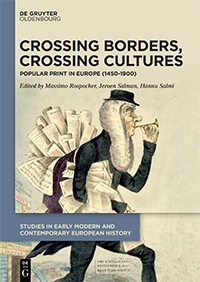Crossing Borders, Crossing Cultures
Popular Print in Europe (1450-1900)
Massimo Rospocher, Jeroen Salman, Hannu Salmi (edd)

Numero: 1
Editore: De Gruyter Oldenbourg
Città: Berlin/Boston
Anno: 2019
Pagine: 296
Cartaceo
E-book
| ISBN: | 978-3-11-64354-1 (PDF) 978-3-11-063989-6 (EPUB) |
Libro
"This volume explores the challenges and possibilities of research into the European dimensions of popular print culture. Popular print culture has traditionally been studied with a national focus. Recent research has revealed, however, that popular print culture has many European dimensions and shared features. A group of specialists in the field has started to explore the possibilities and challenges of research on a wide, European scale. This volume contains the first overview and analysis of the different approaches, methodologies and sources that will stimulate and facilitate future comparative research. This volume first addresses the benefits of a media-driven approach, focusing on processes of content recycling, interactions between text and image, processes of production and consumption. A second perspective illuminates the distribution and markets for popular print, discussing audiences, prices and collections. A third dimension refers to the transnational dimensions of genres, stories, and narratives. A last perspective unravels the communicative strategies and dynamics behind European bestsellers. This book is a source of inspiration for everyone who is interested in research into transnational cultural exchange and in the fascinating history of popular print culture in Europe."
Indice
Contents
Massimo Rospocher and Jeroen Salman
Introduction: Crossing Borders, Crossing Cultures
I. Media, Intermediality
Daniel Bellingradt
The Dynamic of Communication and Media Recycling in Early Modern Europe: Popular Prints as Echoes and Feedback Loops
Rebecca Carnevali
Iconographies and Material Culture of Illustrated Cheap Print from Post-Tridentine Bologna
Andreas Würgler
“Popular Print in German” (1400-1800). Problems and Projects
II. Markets, Prices, and Collections
Francesca Tancini
The Railway Library and Other Literary Rubbish that Travels by the Rail
Goran Proot
Shifting Price Levels of Books Produced at the Officina Plantiniana in Antwerp, 1580–1655
Flavia Bruni
Faraway, So Close: Frontier Challenges for Inter-National Bibliographies
III. Transnational Approaches
Jean-François Botrel and Juan Gomis
“Literatura de cordel” from a Transnational Perspective. New Horizons for an Old Field of Study
Alice Colombo
The Translational Dimension of Street Literature. The Nineteenth-Century Italian Repertoire
VI. Contents
Jordi Sánchez-Martí
The Printed Popularization of the Iberian Books of Chivalry across Sixteenth- Century Europe
Julia Martins
The Afterlife of Italian Secrets: Translating Medical Recipes in Early Modern Europe
Niall Ó Ciosáin
Popular Print in Unofficial Languages. Ireland, Scotland, Wales, and Brittany
IV. Genres and European Bestsellers
Claudia Demattè
The Spanish Romances about Chivalry. A Renaissance Editorial Phenomenon on Which “The Sun Never Set”
Elisa Marazzi
Crossing Genres: A Newcomer in the Transnational History of Almanacs
Reinhart Siegert
The Greatest German Book Success of the Eighteenth Century. Rudolph Zacharias Becker’s “Noth- und Hülfsbüchlein” (1788/1798) as the Prototype of Printed Volksaufklärung and its Dissemination in Europe
Rita Schlusemann
A Canon of Popular Narratives in Six European Languages between 1470 and 1900. The “Griseldis”-Tradition in German and Dutch
Contributors
Index
Parole chiave
- Genres and Media in Cultural Studies
- Early Modern and Modern History
- Cultural History
Recensioni
- "Nachdem die europäische Buchgeschichte bislang stark von nationalen Forschungstraditionen geprägt war, setzt sich der vorliegende Band das löbliche Ziel, komparative und transnational ausgerichtete Forschungen zu erleichtern und zu stimulieren. [...] Das Buch und die zahlreichen darin enthaltenen Abbildungen sind ansprechend gestaltet. Es wird deutlich, dass die neuzeitlichen Buchmärkte zwar stark national geprägt waren, aber vielfältige Verflechtungen bestanden, die nicht als losgelöst von generellen soziokulturellen Entwicklungen zu betrachten sind. [...] Es sind ihm eine große Leserschaft und zahlreiche daran anknüpfende Forschungen zu wünschen, damit die transnationale Dimension des europäischen Druckwesens mehr Beachtung findet." – Doris Gruber, in "Zeitschrift für Historische Forschung", 48, 2021, 1, S. 133 f.;
- "Dal punto di vista metodologico gli studiosi che hanno collaborato alla stesura di questo libro sono stati inclusivi rispetto agli oggetti su cui si sono focalizzati: evitando categorizzazioni univoche, hanno piuttosto considerato tutto lo spettro dei testi e materiali rivolti a un ampio pubblico. [...] Uno degli obbiettivi più ambiziosi di questa ricerca è stato il tentativo di presentare possibili metodologie per uno studio comparativo da un punto di vista paneuropeo. Il focus, inoltre, non è solo sull’origine di questi testi e sulla loro traduzione, ma soprattutto sulla loro produzione e sul loro consumo." - Erica Bertelegni, in "Bibliothecae.it", 11, 2022, 1, 451-451.

